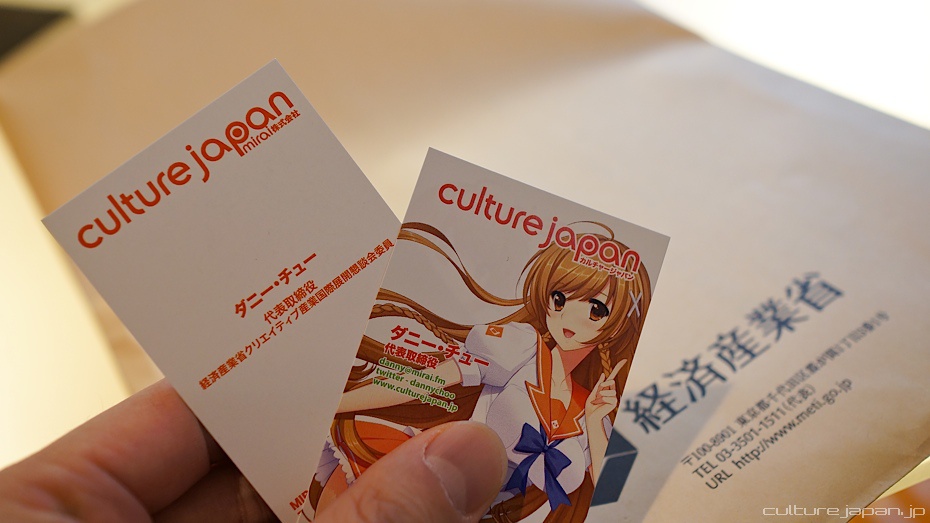
As announced earlier this month, The Japanese government appointed me as a member of the "Ministry of Economy, Trade and Industry Creative Industries Internationalization Committee" [経済産業省クリエイティブ産業国際展開懇談会] - its a mouth full in Japanese and even more of a mouthful in English so you and I will refer to it as "METI CIIC" from now ^^;
The committee meets once a month at the ministry to raise topics, discuss issues which will lead to a plan of action regarding the internationalization of Japan's creative industries.
This first photo taken at the 2nd meeting last week with fellow committee members who are Presidents of companies such as Bandai Namco Games, Sony Music Entertainment, Horipro, Kodansha, Isetan, Mitsui Fudousan, TBS and Gaga Corporation. The gentleman standing next to my right is Isshu Sugawara - the State Minister of Economy, Trade and Industry. The full member list is up at the METI website.

My new position working with the Japanese government earns me a new title and thus a new business card ^^; 2 may seem a handful but I've been given 5 cards from the same person before ^^;

Government buildings are located in the Kasumigaseki area of Tokyo which is very close to Hibiya Park.

A summary of the previous meeting is posted by the government a few weeks later on the METI website. Below is a translation of the summary.
- The preconception that foreigners will only buy bootlegs and cheap products needs to be stopped. The need for official products overseas is very high. The market environment needs to be improved in order to sell more Japanese products overseas.
- Smartphone content and social games are a powerful industry in Japan and can easily be focused on to have an influential economic effect.
- There are almost no children in Asia that don't know of Japan's anime and games, however there are no sales of these anime and games in many of these regions. Many first think it’s best to combat pirated versions, but on the other hand there are many customers who currently enjoy pirated content. In order to understand these needs better, companies should create business models that incorporate small transactions through hardware such as smartphones which are used worldwide.
- A mix of traditional and modern, West and East are incredibly important in achieving new innovations. A part of promoting 'Cool Japan' is to proactively take part in such endeavors.
- Businesses that want to expand overseas are currently often left unable to purchase land. The reason for this can often be attributed to the Ministry of Foreign Affairs in other countries or government funding. The situation calls for measures that overcome these problems.
- The worth of products won't be conveyed effectively if products are simply sold as is, what's important is how exactly this worth is built up in the eyes of consumers. Particularly in overseas countries, products won't become popular without this build up. It may be best to first develop new things locally and attempt to improve this 'worth'. It's also important to convey the background and concept of products to consumers, as well as have someone who can pass this information on effectively.
- Fashion is generally a small to medium-sized industry, so it's probably best to create a base of operations overseas and advance into the market from there. Somewhere to collect and put together information is necessary to expand.
- Even with the Senkaku island problems in China, there is still a demand for Japanese products.
- When expanding overseas, it's important to consider how you intend to customize your business or products for the local market.
- Japanese fashion is attracting a lot of attention throughout Asia. There are more copies of fashion magazines across the rest of Asia then there are in Japan. The current problems however are those of trademarks and pirated goods. In order to further develop the fashion industry into the overseas market, it is necessary to join up with various other industries.
- At Japan-related events hosted overseas, people from all sorts of different countries sing Japanese songs. These are mostly songs that are popular on YouTube. Many foreigners used to pick up pirated versions of these songs, but are now picking up more and more official versions instead.
The reasons behind this is because official products actually include sound and often because they are limited editions which include special bonuses. From the view point of a Japanese person, these are worth about 20000 yen. It's likely best to target these wealthy consumers first.
- Just as the Japanese Embassy of Italy has Ferrari exhibitions in Japan, Japanese Embassies and consulates overseas should open up to such ventures for businesses.
- Businesses should first put effort into privately expanding overseas. While there, they can learn more of what supportive measures are available in each country.
- Blended interaction with customers (inbound and outbound) should be considered. Japanese markets have proved they can draw in customers through inbound methods that pull the customer in, which means if they attempt to go out and sell with outbound methods, they are likely to succeed.
- Step one is the dissemination of information, and not only with new content but also simultaneously through a mix of the Internet and broadcasts, real events and social networking. When it comes to social networking, people are the key to effective transmission of information. How much of a personalized, influential network you can create is important to consider.
- There is only so far you can go by expanding overseas by opening up a retail store. It's important to think of new types of products, but they should always incorporate Japanese culture as a part of them.
- Consumer content, commercial establishments and simple consumer goods and services need to all be fused together into a single package to create a boom. Connecting all these together will lead to more effective trade, and this connection is an important role of Cool Japan. These basic roles need to be further discussed.
- A revised budget of 15,500,000,000 yen (1.5 billion USD) has been allocated for the localization and promotion of content into the overseas market. Step one is to consider how to use this proactively to achieve effective results.
The round table is only 1 hour so we dont get to cover a lot. From the next meeting however, we are required to submit reports. For the second meeting (which will be summarised at the METI website in a few weeks) I raised a point that its important to allow fans of Japanese content to help spread Japanese culture.
There does not seem to be many rights issues in Korea which is one of the reasons why Korean content can be distributed easily but most of that distributing is done by fans of Korean culture.
If you go to a KPOP concert, you are usually allowed to take photos or video footage - much of that is shared on YouTube and you can find about 340,000 results on YouTube for "KPOP Concert" - and the results actually show KPOP Concerts.
If you do a search for "JPOP Concert" on YouTube however, you get 35,000 results and hardly any concert footage.
The reason is that management of Japanese artists/record labels dont allow fans to take photos or videos and even if somebody did, the record labels usually use music matching to automatically pull any footage that contains music that they own from YouTube.
A friend of mine set up a facebook fan page for a Japanese artist - only to have the record label make a claim to Facebook to shutdown the page and give the fan a warning - talk about stabbing fans in the back.
Information about Japanese content in English is few and far between so fans help by creating websites and fan pages - but the Japanese content owners go and do their best to remove that information from the internet.
After raising this issue, the minister took these points as being in need of serious revision of how Japanese artist and content rights are managed.

Meeting done for the day - I'll post the translated summary of today's meeting when its up. Heading back to the station. Tokyo Tower in the background.

Nothing like some Gusuto to fill up at the end of the day.

One of my agenda items is to revitalize the "Machikoba" [町工場[まちこうば]] which are small factories dotted around Japan who specialise in a certain craft or technique - it can be anything from making moulds, slush casting, making gears, leather goods and so on. In some cases, these small factories have been around for many generations where technology and know how is passed down the blood line.
In some cases however, many of these small factories have shutdown either due to lack of people to pass on the know how to or due to the lack of new orders - many of which is being channeled to factories overseas.
This is a slide from one of my decks. It shows how I'm going to pair up Japanese creators and the small factories together - the work of Japanese creators can then be developed with the help of the small factories. I will showcase the resulting products to folks overseas and in doing so I meet the goal of promoting Japanese technology and creativity to the rest of the world.
There are many creators in Japan who just dont know which factories to use - many of which are not even listed on the Internets so you need to know somebody who does.
Most Japanese figures and dolls are licensed from anime or games which is one of the reason why these products are kept in Japan - because of the previously mentioned licensing issues.
If more individual creators made their own original character dolls or figures then these products should not have any of the said licensing issues and it will be easier to spread the Japanese technology and craftsmanship that goes into these products around the world.

This is a doll of Mirai Suenaga - a project which I've been working on for the past half year. You can see how she was made in this post - many people thought it was an April fools ^^;
Through the production of Mirai, I will be highlighting the various factories that I use to make her so that not only Japanese creators but you too can use the small factories in Japan to create your own dolls and figures. Dolls are made using a technique called slush casting - the moulds are much cheaper than injection casting and is just about affordable for many individuals.
I will be creating a website which has a directory of factories. The plan is for me to visit these factories one by one and take photos of their facilities - then stick them up on the website.
I also plan to have a directory of producers who speak Japanese & English too so that you can go through them if you dont speak the lingo or cant travel to Japan often. I'm also going to have a list of job openings for folks who are interested in working in one of these small factories.

I have hooked up with folks at the Tokyo Chamber of Commerce and Industry who I'm going to work with on this project.
I will also be highlighting small factories who specialise in not just doll or plastics manufacture but also leather and other materials and crafts too with the aim of making it easier for you to turn your creative ideas into a reality.
Is there something that you have always wanted to make and mass produce?

Read more about Mirai Suenaga >>>


